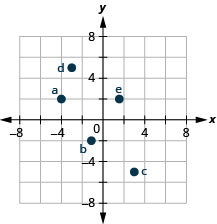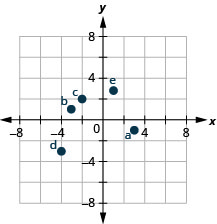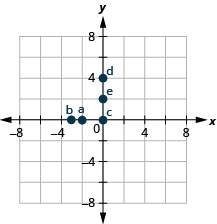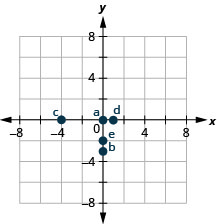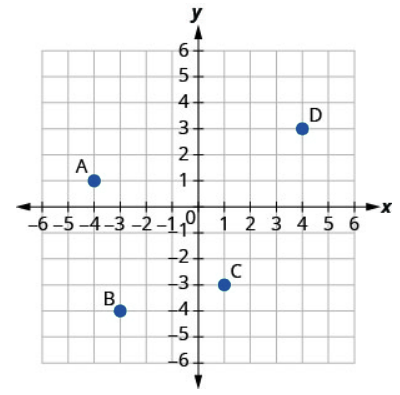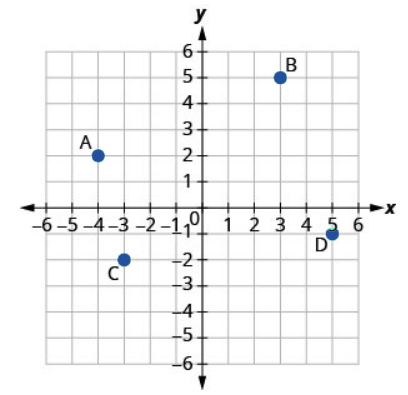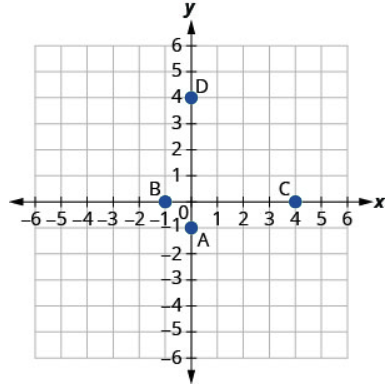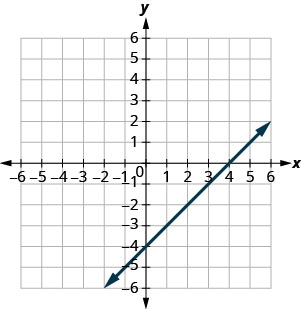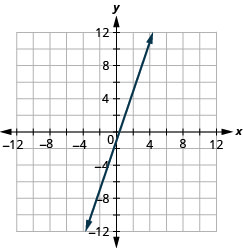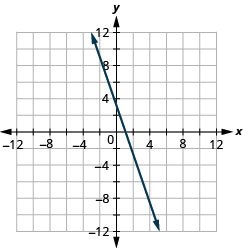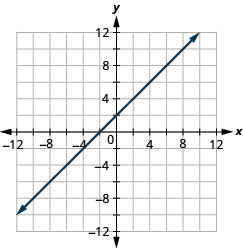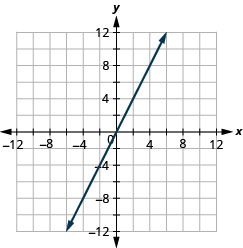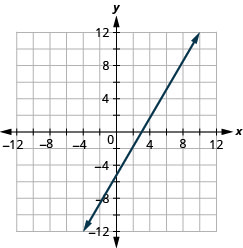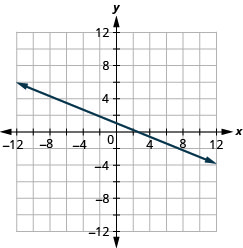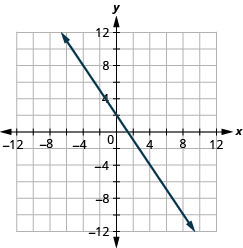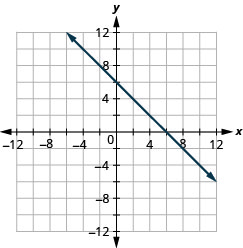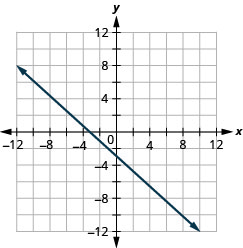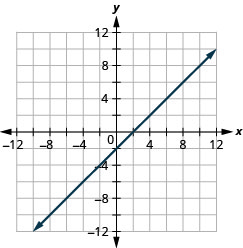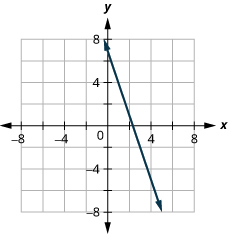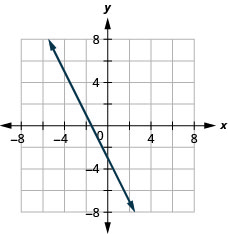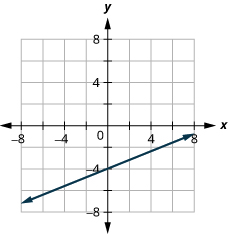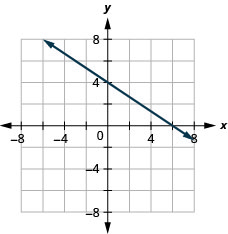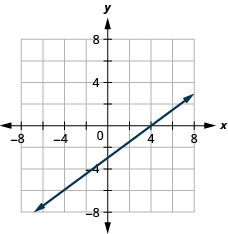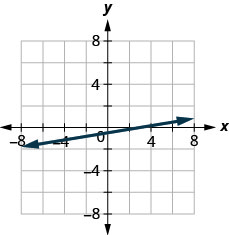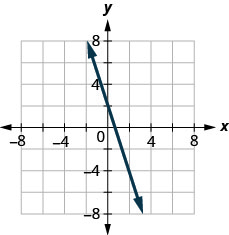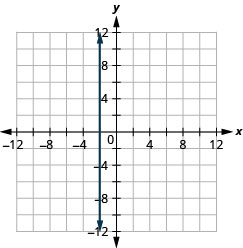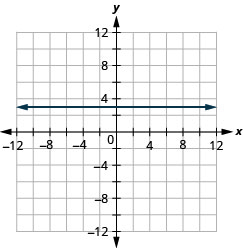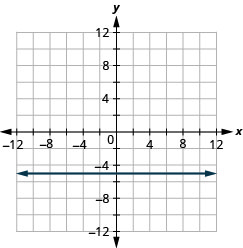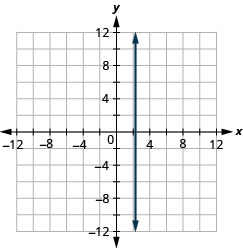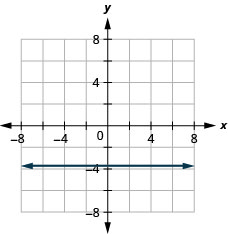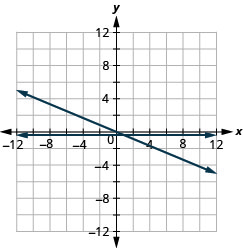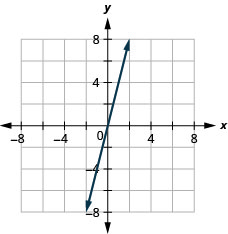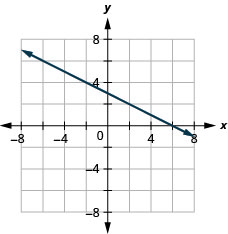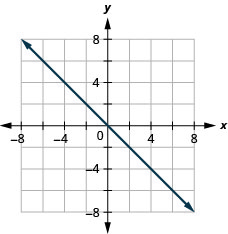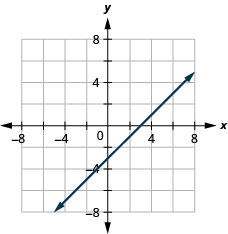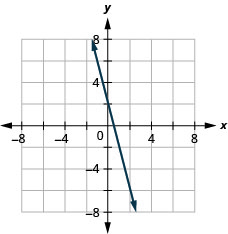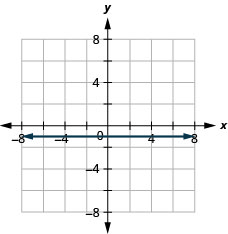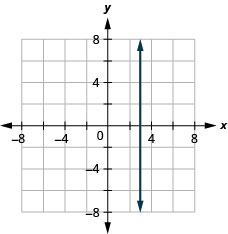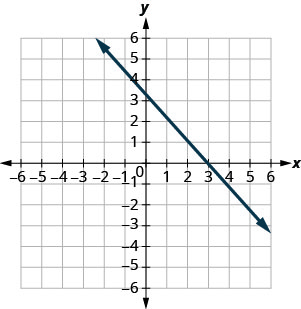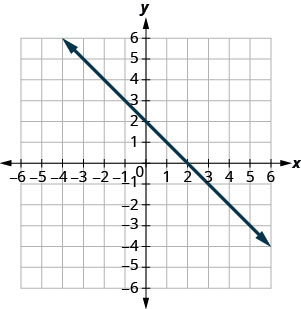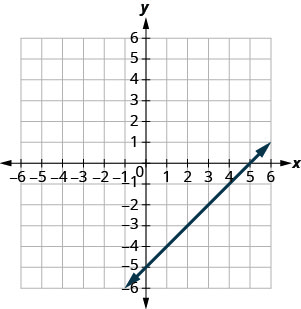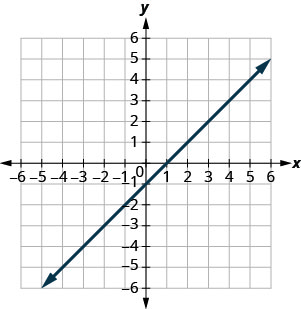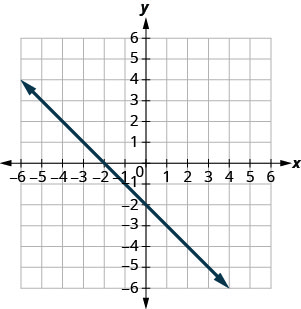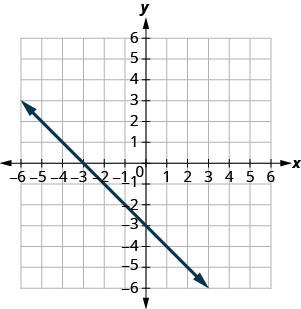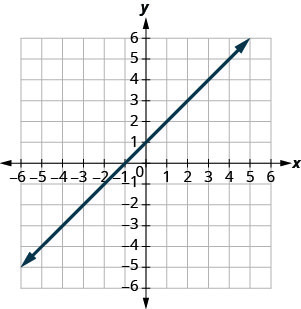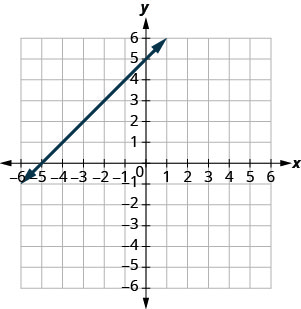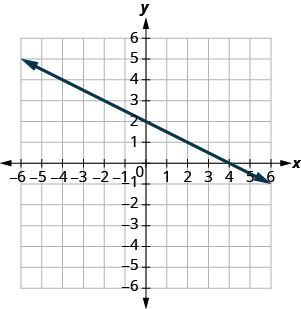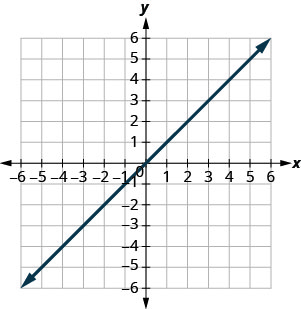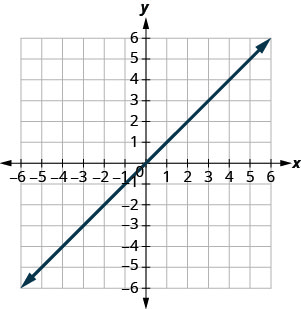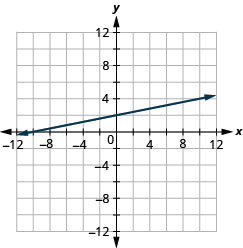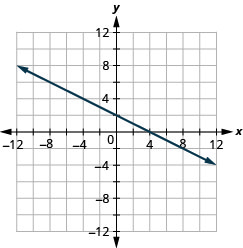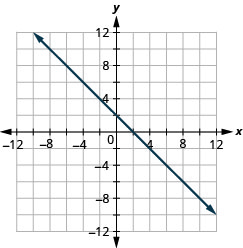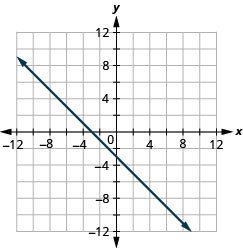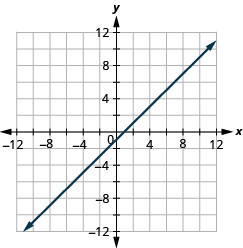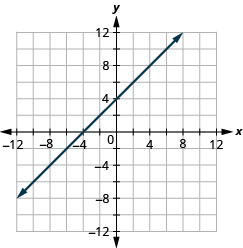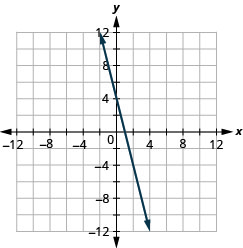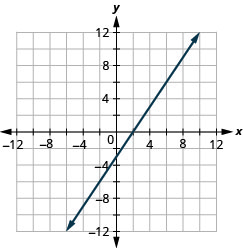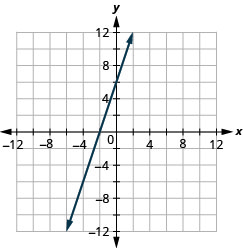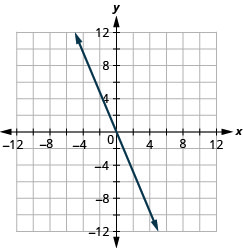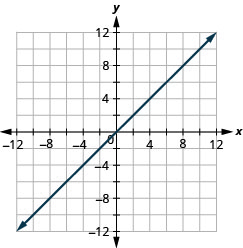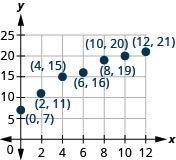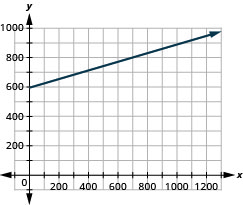Exercises: Graph Linear Equations in Two Variables (3.9)
Exercises: Plot Points in a Rectangular Coordinate System
Instructions: For questions 1-8, plot each point in a rectangular coordinate system and identify the quadrant in which the point is located.
1.
a.[latex](-4,2)[/latex]
b.[latex](-1,-2)[/latex]
c.[latex](3,-5)[/latex]
d.[latex](-3,5)[/latex]
e.[latex]\left(\frac{5}{3},2\right)[/latex]
2.
a.[latex](-2,-3)[/latex]
b.[latex](3,-3)[/latex]
c.[latex](-4,1)[/latex]
d.[latex](4,-1)[/latex]
e.[latex]\left(\frac{3}{2},1\right)[/latex]
3.
a.[latex](3,-1)[/latex]
b.[latex](-3,1)[/latex]
c.[latex](-2,2)[/latex]
d.[latex](-4,-3)[/latex]
e.[latex]\left(1,\frac{14}{5}\right)[/latex]
4.
a.[latex](-1,1)[/latex]
b.[latex](-2,-1)[/latex]
c.[latex](2,1)[/latex]
d.[latex](1,-4)[/latex]
e.[latex]\left(3,\frac{7}{2}\right)[/latex]
5.
a.[latex]\left(-2,0\right)[/latex]
b.[latex]\left(-3,0\right)[/latex]
c.[latex]\left(0,0\right)[/latex]
d.[latex]\left(0,4\right)[/latex]
e.[latex]\left(0,2\right)[/latex]
6.
a.[latex]\left(0,1\right)[/latex]
b.[latex]\left(0,-4\right)[/latex]
c.[latex]\left(-1,0\right)[/latex]
d.[latex]\left(0,0\right)[/latex]
e.[latex]\left(5,0\right)[/latex]
7.
a.[latex]\left(0,0\right)[/latex]
b.[latex]\left(0,-3\right)[/latex]
c.[latex]\left(-4,0\right)[/latex]
d.[latex]\left(1,0\right)[/latex]
e.[latex]\left(0,-2\right)[/latex]
8.
a.[latex]\left(-3,0\right)[/latex]
b.[latex]\left(0,5\right)[/latex]
c.[latex]\left(0,-2\right)[/latex]
d.[latex]\left(2,0\right)[/latex]
e.[latex]\left(0,0\right)[/latex]
Exercises: Name Ordered Pairs in a Rectangular Coordinate System
Instructions: For questions 9-12, name the ordered pair of each point shown in the rectangular coordinate system.
9.
Solution
A: [latex](-4,1)[/latex]
B: [latex](-3,-4)[/latex]
C: [latex](1,-3)[/latex]
D: [latex](4,3)[/latex]
Solution
A: [latex](0,-2)[/latex]
B: [latex](-2,0)[/latex]
C: [latex](0,5)[/latex]
D: [latex](5,0)[/latex]
Exercises: Verify Solutions to an Equation in Two Variables
Instructions: For questions 13-20, which ordered pairs are solutions to the given equations?
13. [latex]2x+y=6[/latex]
a.[latex](1,4)[/latex]
b.[latex](3,0)[/latex]
c.[latex](2,3)[/latex]
Solution
a, b
14. [latex]x+3y=9[/latex]
a.[latex](0,3)[/latex]
b.[latex](6,1)[/latex]
c.[latex](-3,-3)[/latex]
15. [latex]4x-2y=8[/latex]
a.[latex](3,2)[/latex]
b.[latex](1,4)[/latex]
c.[latex](0,-4)[/latex]
Solution
a, c
16. [latex]3x-2y=12[/latex]
a.[latex](4,0)[/latex]
b.[latex](2,-3)[/latex]
c.[latex](1,6)[/latex]
17. [latex]y=4x+3[/latex]
a.[latex](4,3)[/latex]
b.[latex](-1,-1)[/latex]
c.[latex]\left(\frac{1}{2},5\right)[/latex]
Solution
b, c
18. [latex]y=2x-5[/latex]
a.[latex](0,-5)[/latex]
b.[latex](2,1)[/latex]
c.[latex]\left(\frac{1}{2},-4\right)[/latex]
19. [latex]y=\frac{1}{2}x-1[/latex]
a.[latex](2,0)[/latex]
b.[latex](-6,-4)[/latex]
c.[latex](-4,-1)[/latex]
Solution
a, b
20. [latex]y=\frac{1}{3}x+1[/latex]
a.[latex](-3,0)[/latex]
b.[latex](9,4)[/latex]
c.[latex](-6,-1)[/latex]
Exercises: Complete a Table of Solutions to a Linear Equation
Instructions: For questions 21-32, complete the table to find solutions to each linear equation.
21. [latex]y=2x-4[/latex]
| [latex]x[/latex] | [latex]y[/latex] | [latex](x,y)[/latex] |
| [latex]0[/latex] | ||
| [latex]2[/latex] | ||
| [latex]-1[/latex] |
Solution
| [latex]x[/latex] | [latex]y[/latex] | [latex]\left(x,y\right)[/latex] |
| [latex]0[/latex] | [latex]-4[/latex] | [latex]\left(0,-4\right)[/latex] |
| [latex]2[/latex] | [latex]0[/latex] | [latex]\left(2,0\right)[/latex] |
| [latex]-1[/latex] | [latex]-6[/latex] | [latex]\left(-1,-6\right)[/latex] |
22. [latex]y=3x-1[/latex]
| [latex]x[/latex] | [latex]y[/latex] | [latex]\left(x,y\right)[/latex] |
| [latex]0[/latex] | ||
| [latex]2[/latex] | ||
| [latex]-1[/latex] |
23. [latex]y=-x+5[/latex]
| [latex]x[/latex] | [latex]y[/latex] | [latex]\left(x,y\right)[/latex] |
| [latex]0[/latex] | ||
| [latex]3[/latex] | ||
| [latex]-2[/latex] |
Solution
| [latex]x[/latex] | [latex]y[/latex] | [latex]\left(x,y\right)[/latex] |
| [latex]0[/latex] | [latex]5[/latex] | [latex]\left(0,5\right)[/latex] |
| [latex]3[/latex] | [latex]2[/latex] | [latex]\left(3,2\right)[/latex] |
| [latex]-2[/latex] | [latex]7[/latex] | [latex]\left(-2,7\right)[/latex] |
24. [latex]y=-x+2[/latex]
| [latex]x[/latex] | [latex]y[/latex] | [latex]\left(x,y\right)[/latex] |
| [latex]0[/latex] | ||
| [latex]3[/latex] | ||
| [latex]-2[/latex] |
25. [latex]y=\frac{1}{3}x+1[/latex]
| [latex]x[/latex] | [latex]y[/latex] | [latex]\left(x,y\right)[/latex] |
| [latex]0[/latex] | ||
| [latex]3[/latex] | ||
| [latex]6[/latex] |
Solution
| [latex]x[/latex] | [latex]y[/latex] | [latex]\left(x,y\right)[/latex] |
| [latex]0[/latex] | [latex]1[/latex] | [latex]\left(0,1\right)[/latex] |
| [latex]3[/latex] | [latex]2[/latex] | [latex]\left(3,2\right)[/latex] |
| [latex]6[/latex] | [latex]3[/latex] | [latex]\left(6,3\right)[/latex] |
26. [latex]y=\frac{1}{2}x+4[/latex]
| [latex]x[/latex] | [latex]y[/latex] | [latex]\left(x,y\right)[/latex] |
| [latex]0[/latex] | ||
| [latex]2[/latex] | ||
| [latex]4[/latex] |
27. [latex]y=-\frac{3}{2}x-2[/latex]
| [latex]x[/latex] | [latex]y[/latex] | [latex]\left(x,y\right)[/latex] |
| [latex]0[/latex] | ||
| [latex]2[/latex] | ||
| [latex]-2[/latex] |
Solution
| [latex]x[/latex] | [latex]y[/latex] | [latex]\left(x,y\right)[/latex] |
| [latex]0[/latex] | [latex]-2[/latex] | [latex]\left(0,-2\right)[/latex] |
| [latex]2[/latex] | [latex]-5[/latex] | [latex]\left(2,-5\right)[/latex] |
| [latex]-2[/latex] | [latex]1[/latex] | [latex]\left(-2,1\right)[/latex] |
28. [latex]y=-\frac{2}{3}x-1[/latex]
| [latex]x[/latex] | [latex]y[/latex] | [latex]\left(x,y\right)[/latex] |
| [latex]0[/latex] | ||
| [latex]3[/latex] | ||
| [latex]-3[/latex] |
29. [latex]x+3y=6[/latex]
| [latex]x[/latex] | [latex]y[/latex] | [latex]\left(x,y\right)[/latex] |
| [latex]0[/latex] | ||
| [latex]3[/latex] | ||
| [latex]0[/latex] |
Solution
| [latex]x[/latex] | [latex]y[/latex] | [latex]\left(x,y\right)[/latex] |
| [latex]0[/latex] | [latex]2[/latex] | [latex]\left(0,2\right)[/latex] |
| [latex]3[/latex] | [latex]4[/latex] | [latex]\left(3,1\right)[/latex] |
| [latex]6[/latex] | [latex]0[/latex] | [latex]\left(6,0\right)[/latex] |
30. [latex]x+2y=8[/latex]
| [latex]x[/latex] | [latex]y[/latex] | [latex]\left(x,y\right)[/latex] |
| [latex]0[/latex] | ||
| [latex]4[/latex] | ||
| [latex]0[/latex] |
31. [latex]2x-5y=10[/latex]
| [latex]x[/latex] | [latex]y[/latex] | [latex]\left(x,y\right)[/latex] |
| [latex]0[/latex] | ||
| [latex]10[/latex] | ||
| [latex]0[/latex] |
Solution
| [latex]x[/latex] | [latex]y[/latex] | [latex]\left(x,y\right)[/latex] |
| [latex]0[/latex] | [latex]-2[/latex] | [latex]\left(0,-2\right)[/latex] |
| [latex]10[/latex] | [latex]2[/latex] | [latex]\left(10,2\right)[/latex] |
| [latex]5[/latex] | [latex]0[/latex] | [latex]\left(5,0\right)[/latex] |
32. [latex]3x-4y=12[/latex]
| [latex]x[/latex] | [latex]y[/latex] | [latex]\left(x,y\right)[/latex] |
| [latex]0[/latex] | ||
| [latex]8[/latex] | ||
| [latex]0[/latex] |
Exercises: Find Solutions to a Linear Equation
Instructions: For questions 33-48, find three solutions to each linear equation.
33. [latex]y=5x-8[/latex]
Solution
Answers will vary.
Solution
Answers will vary.
Solution
Answers will vary.
Solution
Answers will vary.
Solution
Answers will vary.
Solution
Answers will vary.
Solution
Answers will vary.
Solution
Answers will vary.
48. [latex]4x-3y=12[/latex]
Exercises: Recognize the Relationship Between the Solutions of an Equation and its Graph
Instructions: For questions 49-52, for each ordered pair, decide:
a. Is the ordered pair a solution to the equation?
b. Is the point on the line?
49. [latex]y=x+2[/latex]
a.[latex]\left(0,2\right)[/latex]
b.[latex]\left(1,2\right)[/latex]
c.[latex]\left(-1,1\right)[/latex]
d.[latex]\left(-3,-1\right)[/latex]
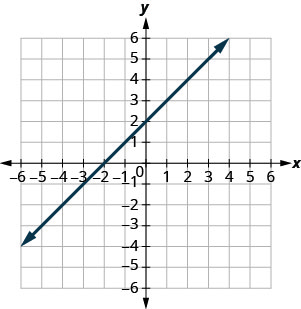
Solution
a. yes; no
b. no; no
c. yes; yes
d. yes; yes
51. [latex]y=\frac{1}{2}x-3[/latex]
a.[latex]\left(0,-3\right)[/latex]
b.[latex]\left(2,-2\right)[/latex]
c.[latex]\left(-2,-4\right)[/latex]
d.[latex]\left(4,1\right)[/latex]
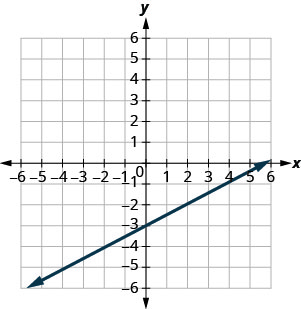
Solution
a. yes; yes
b. yes; yes
c. yes; yes
d. no; no
Exercises: Graph a Linear Equation by Plotting Points
Instructions: For questions 53-96, graph by plotting points.
53. [latex]y=3x-1[/latex]
Exercises: Graph Vertical and Horizontal Lines
Instructions: For questions 97-108, graph each equation.
Exercises: Graph a Pair of Equations in the Same Rectangular Coordinate System
Instructions: For questions 109-112, graph each pair of equations in the same rectangular coordinate system.
Exercises: Mixed Practice
Exercises: Identify the [latex]\color{White} x[/latex] and [latex]\color{White} y[/latex]-Intercepts on a Graph
Exercises: Find the [latex]\color{White} x[/latex] and [latex]\color{White} y[/latex]-Intercepts from an Equation of a Line
141. [latex]x+y=4[/latex]
Solution
[latex]\left(4,0\right),\left(0,4\right)[/latex]
Solution
[latex]\left(-2,0\right),\left(0,-2\right)[/latex]
Solution
[latex]\left(5,0\right),\left(0,-5\right)[/latex]
Solution
[latex]\left(-3,0\right),\text{}\left(0,3\right)[/latex]
Solution
[latex]\left(8,0\right),\left(0,4\right)[/latex]
Solution
[latex]\left(2,0\right),\left(0,6\right)[/latex]
Solution
[latex]\left(12,0\right),\left(0,-4\right)[/latex]
Solution
[latex]\left(2,0\right),\left(0,-8\right)[/latex]
Solution
[latex]\left(5,0\right),\left(0,2\right)[/latex]
Solution
[latex]\left(4,0\right),\left(0,-6\right)[/latex]
Solution
[latex]\left(3,0\right),\left(0,1\right)[/latex]
Solution
[latex]\left(-10,0\right),\left(0,2\right)[/latex]
Solution
[latex]\left(0,0\right)[/latex]
Solution
[latex]\left(0,0\right)[/latex]
Exercises: Graph a Line Using the Intercepts
Instructions: For questions 169-194, graph using the intercepts.
Exercises: Everyday Math
195. Weight of a baby. Mackenzie recorded her baby’s weight every two months. The baby’s age, in months, and weight, in pounds, are listed in the table below, and shown as an ordered pair in the third column.
a. Plot the points on a coordinate plane.
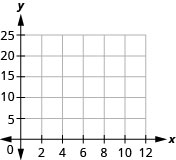
b. Why is only Quadrant I needed?
| Age [latex]x[/latex] | Weight [latex]y[/latex] | [latex]\left(x,y\right)[/latex] |
| [latex]0[/latex] | [latex]7[/latex] | [latex](0,7)[/latex] |
| [latex]2[/latex] | [latex]11[/latex] | [latex](2,11)[/latex] |
| [latex]4[/latex] | [latex]15[/latex] | [latex](4,15)[/latex] |
| [latex]6[/latex] | [latex]16[/latex] | [latex](6,16)[/latex] |
| [latex]8[/latex] | [latex]19[/latex] | [latex](8,19)[/latex] |
| [latex]10[/latex] | [latex]20[/latex] | [latex](10,20)[/latex] |
| [latex]12[/latex] | [latex]21[/latex] | [latex](12,21)[/latex] |
196. Weight of a child. Latresha recorded her son’s height and weight every year. His height, in inches, and weight, in pounds, are listed in the table below, and shown as an ordered pair in the third column.
a. Plot the points on a coordinate plane.
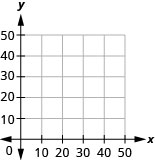
b. Why is only Quadrant I needed?
| Height [latex]x[/latex] | Weight [latex]y[/latex] | [latex]\left(x,y\right)[/latex] |
| [latex]28[/latex] | [latex]22[/latex] | [latex](28,22)[/latex] |
| [latex]31[/latex] | [latex]27[/latex] | [latex](31,27)[/latex] |
| [latex]33[/latex] | [latex]33[/latex] | [latex](33,33)[/latex] |
| [latex]37[/latex] | [latex]35[/latex] | [latex](37,35)[/latex] |
| [latex]40[/latex] | [latex]41[/latex] | [latex](40,41)[/latex] |
| [latex]42[/latex] | [latex]45[/latex] | [latex](42,45)[/latex] |
198. Weekly earnings. At the art gallery where he works, Salvador gets paid [latex]$200[/latex] per week plus [latex]15\%[/latex] of the sales he makes, so the equation [latex]y=200+0.15x[/latex] gives the amount, [latex]y[/latex], he earns for selling [latex]x[/latex] dollars of artwork. Calculate the amount Salvador earns for selling [latex]$900[/latex], [latex]$1600[/latex], and [latex]$2000[/latex], and then graph the line.
199. Road trip. Damien is driving from Chicago to Denver, a distance of [latex]1000 miles. The [latex]x[/latex]-axis on the graph below shows the time in hours since Damien left Chicago. The [latex]y[/latex]-axis represents the distance he has left to drive.
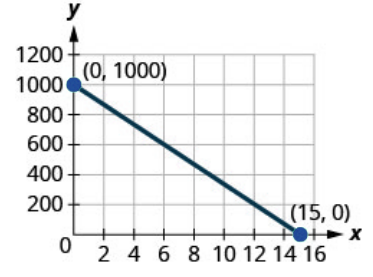
a. Find the [latex]x[/latex] and [latex]y[/latex]-intercepts.
b. Explain what the [latex]x[/latex] and [latex]y[/latex]-intercepts mean for Damien.
Solution
a.[latex](0,1000),(15,0)[/latex]
b. At [latex](0,1000)[/latex], he has been gone [latex]0[/latex] hours and has [latex]1000[/latex] miles left. At [latex](15,0)[/latex], he has been gone [latex]15[/latex] hours and has [latex]0[/latex] miles left to go.
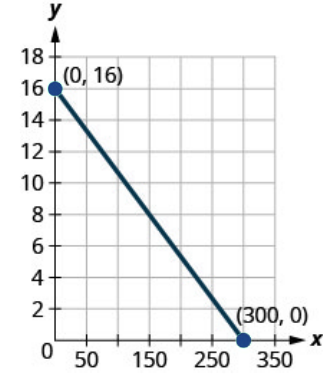
a. Find the [latex]x[/latex] and [latex]y[/latex]-intercepts.
b. Explain what the [latex]x[/latex] and [latex]y[/latex]-intercepts mean for Ozzie.
Exercises: Writing Exercises
Solution
Answers will vary.
Solution
Answers will vary.
205. Explain how you would choose three [latex]x[/latex]-values to make a table to graph the line [latex]y=\frac{1}{5}x-2[/latex].
Solution
Answers will vary.
206. What is the difference between the equations of a vertical and a horizontal line?
Solution
Answers will vary.
Solution
Answers will vary.

